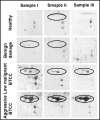Identification of Apo-A1 as a biomarker for early diagnosis of bladder transitional cell carcinoma
- PMID: 21496341
- PMCID: PMC3089778
- DOI: 10.1186/1477-5956-9-21
Identification of Apo-A1 as a biomarker for early diagnosis of bladder transitional cell carcinoma
Abstract
Background: Bladder transitional cell carcinoma (BTCC) is the fourth most frequent neoplasia in men, clinically characterized by high recurrent rates and poor prognosis. Availability of urinary tumor biomarkers represents a convenient alternative for early detection and disease surveillance because of its direct contact with the tumor and sample accessibility.
Results: We tested urine samples from healthy volunteers and patients with low malignant or aggressive BTCC to identify potential biomarkers for early detection of BTCC by two-dimensional electrophoresis (2-DE) coupled with mass spectrometry (MS) and bioinformatics analysis. We observed increased expression of five proteins, including fibrinogen (Fb), lactate dehydrogenase B (LDHB), apolipoprotein-A1 (Apo-A1), clusterin (CLU) and haptoglobin (Hp), which were increased in urine samples of patients with low malignant or aggressive bladder cancer. Further analysis of urine samples of aggressive BTCC showed significant increase in Apo-A1 expression compared to low malignant BTCC. Apo-A1 level was measured quantitatively using enzyme-linked immunosorbent assay (ELISA) and was suggested to provide diagnostic utility to distinguish patients with bladder cancer from controls at 18.22 ng/ml, and distinguish patients with low malignant BTCC from patients with aggressive BTCC in two-tie grading system at 29.86 ng/ml respectively. Further validation assay showed that Apo-A1 could be used as a biomarker to diagnosis BTCC with a sensitivity and specificity of 91.6% and 85.7% respectively, and classify BTCC in two-tie grading system with a sensitivity and specificity of 83.7% and 89.7% respectively.
Conclusion: Taken together, our findings suggest Apo-A1 could be a potential biomarker related with early diagnosis and classification in two-tie grading system for bladder cancer.
Figures




Similar articles
-
Discovery of Apo-A1 as a potential bladder cancer biomarker by urine proteomics and analysis.Biochem Biophys Res Commun. 2014 Apr 18;446(4):1047-52. doi: 10.1016/j.bbrc.2014.03.053. Epub 2014 Mar 21. Biochem Biophys Res Commun. 2014. PMID: 24661883
-
[Significance of apolipoprotein A1 as biomarker for early diagnosis and classification of bladder urothelial carcinoma].Zhonghua Lao Dong Wei Sheng Zhi Ye Bing Za Zhi. 2013 Apr;31(4):266-70. Zhonghua Lao Dong Wei Sheng Zhi Ye Bing Za Zhi. 2013. PMID: 23595303 Chinese.
-
Screening and identification of specific markers for bladder transitional cell carcinoma from urine urothelial cells with suppressive subtractive hybridization and cDNA microarray.Can Urol Assoc J. 2011 Dec;5(6):E129-37. doi: 10.5489/cuaj.09118. Epub 2011 Jan 13. Can Urol Assoc J. 2011. PMID: 21251473 Free PMC article.
-
Molecular pathology of low malignant bladder transitional cell carcinoma: a current perspective.Histol Histopathol. 2005 Jan;20(1):147-53. doi: 10.14670/HH-20.147. Histol Histopathol. 2005. PMID: 15578434 Review.
-
Cell-mediated tumour immunity in patients with transitional cell carcinoma of the urinary bladder.Int Urol Nephrol. 1975;7(4):297-302. doi: 10.1007/BF02082119. Int Urol Nephrol. 1975. PMID: 1107249 Review.
Cited by
-
Apolipoprotein A-I (ApoA-I), Immunity, Inflammation and Cancer.Cancers (Basel). 2019 Aug 1;11(8):1097. doi: 10.3390/cancers11081097. Cancers (Basel). 2019. PMID: 31374929 Free PMC article. Review.
-
Changes in salivary analytes in canine parvovirus: A high-resolution quantitative proteomic study.Comp Immunol Microbiol Infect Dis. 2018 Oct;60:1-10. doi: 10.1016/j.cimid.2018.09.011. Epub 2018 Sep 24. Comp Immunol Microbiol Infect Dis. 2018. PMID: 30396423 Free PMC article.
-
Advances in urinary biomarker discovery in urological research.Investig Clin Urol. 2020 Feb;61(Suppl 1):S8-S22. doi: 10.4111/icu.2020.61.S1.S8. Epub 2019 Dec 31. Investig Clin Urol. 2020. PMID: 32055750 Free PMC article. Review.
-
The role of heat shock proteins in bladder cancer.Nat Rev Urol. 2013 Jul;10(7):386-95. doi: 10.1038/nrurol.2013.108. Epub 2013 May 14. Nat Rev Urol. 2013. PMID: 23670183 Review.
-
Comprehensive proteomics and platform validation of urinary biomarkers for bladder cancer diagnosis and staging.BMC Med. 2023 Apr 5;21(1):133. doi: 10.1186/s12916-023-02813-x. BMC Med. 2023. PMID: 37016361 Free PMC article.
References
-
- Karakiewicz PI, Benayoun S, Zippe C, Lüdecke G, Boman H, Sanchez-Carbayo M, Casella R, Mian C, Friedrich MG, Eissa S, Akaza H, Huland H, Hedelin H, Rupesh R, Miyanaga N, Sagalowsky AI, Marberger MJ, Shariat SF. Institutional variability in the accuracy of urinary cytology for predicting recurrence of transitional cell carcinoma of the bladder. BJU Int. 2006;5:997–1001. doi: 10.1111/j.1464-410X.2006.06036.x. - DOI - PubMed
LinkOut - more resources
Full Text Sources
Research Materials
Miscellaneous

